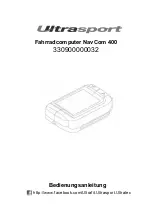
Program P4: OSC Pitch 4–1: OSC Basic
175
Detuned Saw 1
produces two detuned sawtooth
waveforms simultaneously.
Detune
controls the
amount of detuning, and
Wave Morph
adjusts the
volume of the second sawtooth.
Detuned Saw 2
is similar to
Detuned Saw 1
, except
that the second sawtooth is 180 degrees out of phase.
This produces a timbre similar to pulse width
modulation, with the
Detune
parameter controlling
both detune and the speed of the PWM effect.
Triangle
produces a pure tone with relatively few
overtones.
Square/Triangle
simultaneously creates a square wave
(in which the pulse width is fixed at 50%) and a
triangle wave.
Wave Morph
crossfades between the
two.
Initial Phase
[-180…+180, Random]
This controls the initial phase of Oscillator 1, in 1-
degree increments.
Random:
with each note-on, the waveform will start
from a random point along the waveform, to simulate
the varying phase relationships between oscillators in
analog synthesizers.
Wave Morph
[000…100]
The function of this parameter changes depending on
the
Waveform
selection, above.
When
Waveform
is set to either
Saw/Pulse
or
Square/Triangle
,
Wave Morph
crossfades between the
two waveforms. At
0
, you’ll hear only the first
waveform; at
100
, you’ll hear only the second
waveform; and at
50
, you’ll hear an equal mix of both.
When
Waveform
is set to
Double Saw
,
Detuned Saw
1
, or
Detuned Saw 2
,
Wave Morph
controls the
volume of the second Sawtooth wave.
Wave Morph
is not available when the
Waveform
is
set to Saw, Pulse, or Triangle.
AMS
[List of AMS Sources]
This selects an AMS source to control
Wave Morph
.
For a list of AMS sources, see “AMS (Alternate
Modulation Source) List” on page 967.
AMS Intensity
[–100…+100]
This controls the depth and direction of the AMS
modulation for
Wave Morph
.
Pulse Width/Phase/Detune
[000…100]
The name and function of this parameter changes
depending on the
Waveform
selection, above.
When the
Waveform
is set to Pulse or Saw/Pulse, this
is named
Pulse Width
, and controls the width of the
Pulse waveform. For details, see “More on Pulse
Width,” below.
When
Waveform
is set to
Double Saw
, it is named
Phase
, and controls the phase relationship between the
two Sawtooth waves.
When
Waveform
is set to
Detuned Saw 1
or
2
, this is
named
Detune
, and
controls the detune amount
between the two Saws. The adjustments are in half-
cent increments, so that 0 = 0 cents, 50 = 25 cents, and
100 = 50 cents. Saw 1 is tuned up, and Saw 2 is tuned
down, so that the tonal center is maintained.
More on Pulse Width
Pulse waveforms are simple, rectangular shapes. The
Pulse Width sets the percentage of the waveform spent
in the “up” position. A few examples are shown in the
diagram below. Note that a square wave is just a pulse
wave with the width set to 50%.
The width controls the timbre of the oscillator, from
pure and hollow at 50% (a square wave) to thin and
reedy at the extremes.
At settings of
0
and
100–
or when the Pulse Width is
modulated to these values via AMS– the Pulse wave
will be silent, since these eliminate the “pulse”
altogether.
Pulse waveform at different widths
The real magic of the pulse wave comes when you
modulate the width, using the AMS source and
intensity below. Try using a medium-speed triangle
LFO, or a sweeping EG.
AMS
[List of AMS Sources]
This selects an AMS source to control
Pulse
Width/Phase/Detune
. For a list of AMS sources, see
“AMS (Alternate Modulation Source) List” on
page 967.
AMS Intensity
[–100…+100]
This controls the depth and direction of the AMS
modulation for
Width/Phase/Detune
.
Waveform Type and Modulatable Parameters
Waveform Type
Morph
Pulse Width/
Phase/Detune
Saw
n/a
n/a
Pulse
n/a
Pulse Width
Saw/Pulse
Xfade between saw
and pulse
Pulse Width
Double Saw
Volume of 2nd saw
Phase
Detuned Saw 1
Volume of 2nd saw
Detune
Detuned Saw 2
Volume of 2nd saw
Detune and PWM
effect
Triangle
n/a
n/a
Square/Triangle
Xfade between
square & triangle
n/a
Pulse Width = 10%
Pulse Width = 25%
Pulse Width = 75%
Pulse Width = 50%
Summary of Contents for Electronic Keyboard
Page 1: ...Parameter Guide Parameter Guide ...
Page 2: ......
Page 180: ...Program mode EXi 170 ...
Page 290: ...EXi STR 1 Plucked String 280 ...
Page 572: ...Sequencer mode 562 ...
Page 700: ...Global mode 690 ...
Page 751: ...Insert Effects IFX1 IFX12 Routing 741 Fig 2 3a Fig 2 3b ...
Page 902: ...Effect Guide 892 ...
















































